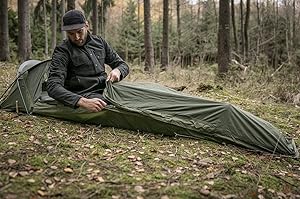
How to Choose a Bivy sack: Buying guide
How to choose a Bivy sack. A bivy sack, also known as a bivouac sack or a bivy bag, is a minimalist outdoor shelter designed to protect you from the elements while minimizing weight and pack size. A bivy sack, also known as a bivouac sack or a bivy bag, is a minimalist outdoor shelter designed to protect you from the elements while minimizing weight and pack size.
Bivy sacks are popular among backpackers, mountaineers, and other outdoor enthusiasts who need a lightweight and compact shelter for emergencies or ultralight camping trips. Choosing the best right bivy sack can be challenging, as there are many factors to consider, including size, weight, materials, and features. In this buying guide, we’ll discuss some of the key factors to consider when choosing a bivy sack.
How to choose a Bivy sack: Buying guide
Size: Bivy sacks come in a range of sizes, from ultra-compact single-person models to larger, more spacious models designed for two people. When choosing a bivy sack, consider the length and width of the sack, as well as the height of the head and foot boxes. You’ll want to choose a size that fits your body comfortably, with enough room to move around and store your gear.
Weight: Bivy sacks are designed to be lightweight and portable, so weight is a crucial consideration. Look for bivy sacks made from lightweight materials, such as Gore-Tex, and choose a size that fits your needs without adding unnecessary weight to your pack.
Materials: Bivy sacks are typically made from waterproof and breathable materials, such as Gore-Tex or eVent. These materials protect from rain, snow, and wind while allowing moisture to escape, preventing condensation inside the sack. Look for bivy sacks with high-quality materials that are durable and long-lasting.
Features: Bivy sacks can come with a range of features, such as zippers, mesh panels for ventilation, and waterproof foot boxes. Consider which features are essential to your needs, and choose a bivy sack with those features.
Price: Bivy sacks can range in price from under $50 to over $500, depending on the size, materials, and features. Consider your budget and choose a bivy sack that fits your needs without breaking the bank.
Conclusion:
Choosing the right bivy sack can be a challenging task, but by considering the factors mentioned above, you’ll be able to find a bivy sack that fits your needs and budget. Remember to consider the size, weight, materials, features, and price when choosing a bivy sack, and look for high-quality materials and construction to ensure your bivy sack will last for many adventures to come. With the right bivy sack, you can enjoy the great outdoors while staying protected and comfortable.
FAQs:
What key features should you prioritize when learning how to choose a bivy sack for outdoor adventures?
When choosing a bivy sack, focus on breathability, waterproof rating, weight, and packed size. A high-quality bivy should balance weather protection with ventilation to prevent condensation. Look for materials like Gore-Tex or Pertex and consider whether you need extra space for gear storage or just minimalist protection for sleeping outdoors.
How does the intended environment affect your decision on how to choose a bivy sack?
Your camping environment greatly influences which bivy sack to choose. For wet, alpine, or winter conditions, opt for a waterproof, durable bivy with sealed seams and storm flaps. In warmer, dry areas, prioritize lightweight, breathable models that allow airflow. Always match the bivy’s material and construction to your expected weather and terrain conditions.
Why is weight and packability important when deciding how to choose a bivy sack?
When backpacking or mountaineering, every ounce matters. Lightweight and compact bivy sacks are ideal for fast-and-light adventures or emergency shelter. However, lighter models may compromise comfort or durability. Balancing weight with protection ensures you stay safe and comfortable without overloading your pack—making packability a crucial factor in choosing the right bivy sack.


